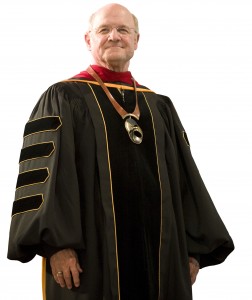
“We are not where we want to be, but we are moving toward it,” said President Ohle during his inaugural address. These words describe the purpose of a brand new initiative for the college. Called Commission Gustavus 150, the plan will “chart the college’s future and prepare [Gustavus] to celebrate its sesquicentennial in 2012,” said Chairperson of the Board of Trustees Jim Gale.
“This is about building on our history, building on what we do well and our strengths and our core values, and asking where that is going to launch us. Provost Mary E. Morton started that dialogue last spring, and President Ohle is spring-boarding off of that into Commission Gustavus 150,” said
Executive Director of Commission Gustavus 150 Barb Larson Taylor.
Gustavus released a strategic plan last year that identified goals to strive for in the college’s future. “Commission Gustavus 150 will implement the strategic plan and involve a lot of people to help us think outside the Gustavus box and identify what we want to see changed or different,” said Taylor.
The college is inviting over 500 people to serve on eight different task forces comprised of St. Peter community members, church leaders, alumni, parents, students and other friends or donors of the college. Each task force will meet once before Thanksgiving and then a few more times before the end of the year, at which point recommendations from each task force will be sent to the Board of Trustees for consideration.
“Once recommendations are sent, the on-campus and off-campus communit[ies] will have an opportunity to voice their opinions on what they think of all the recommendations and what the top priorities are,” said Taylor. Taylor admits that having the on-campus community provide recommendations is especially important, but “[Gustavus] hasn’t fleshed out how that is going to work yet,” said Taylor.
Students on campus who know about Commission Gustavus 150 seem to be pretty excited about it. “I think it’s a good direction. Gustavus, I feel, has kind of been the same for the last three years, so I’m excited for a change. Unfortunately, I won’t be here to directly see it,” said Senior Psychology Major Jessie Niles.
Commission Gustavus 150 is new to this college, but the format has been used by Ohle at the other institutions he has worked at and by a few universities across the country. “This model has been used at the Harvard Graduate School of Business as a case study on constituent-based planning, and while Ohle was at Wartburg College in Iowa,” said Taylor.
Called “Commission Wartburg”, the plan brought a variety of renovations and additions to their campus, something which can be expected here. However, the effects of Commission Wartburg were not viewed as positive by everyone involved.
In a letter sent by four Wartburg faculty members to the College’s Board of Regents in 2005, concern was expressed over the financial repercussions of the initiative. “We are troubled by the lack of initial fund-raising [for Commission Wartburg], which will require that the college borrow $35 million. This will increase Wartburg’s total long-range debt to approximately $88 million.”
The letter goes on to say, “It is our understanding that sound business practice dictates maintaining a debt-to-assets ratio under 30 percent. And according to their IRS Form 990s, most of the colleges with which we like to compare ourselves have managed to cleave pretty close to that mark: Gustavus Adolphus (19 percent), Simpson (20 percent), Buena Vista (21 percent), Augustana-Sioux Falls (25 percent), St. Olaf (25 percent), Luther (29 percent), Nebraska Wesleyan (32 percent). Yet, as of the 2004 fiscal year, Wartburg’s debt-to-assets ratio was 43 percent, almost twice what it was seven years ago.”
The letter concluded by expressing concern over Wartburg’s endowment. “The value of the college’s endowment [in 2005] stands at $35 million. It also appears that the college’s endowment has grown only $3.6 million in the last six years, despite a Commission Wartburg goal of reaching $100 million by the year 2010.”
Certainly money must be spent to improve a college and continue to attract strong students, but how much is too much? For Commission Gustavus 150, President Ohle does not want Gustavus to think about the overall cost of the initiative.
“Typically when we’ve done a campaign here, you look at campaign feasibility, really coming up with a sense of how much are people going to give, what’s the scope that we think we can raise,” said Taylor. However, she reiterated Ohle’s message that Gustavus should not be thinking about money right now.
“With this, the President has been very clear; we are not talking about [the] campaign this next year. These task forces should work not thinking about what it’s going to cost, how much money we’ve raised in the past, not thinking about who would ever give to this, because that of course stifles conversation. Money is off the table, which is fun,” said Taylor.
The Board of Trustees will present its proposal for Commission Gustavus 150, based on the task force recommendations, at the beginning of the 2009-2010 school year. At that point, an aggressive fundraising campaign will begin, setting the stage for potential campus renovations and the celebration of Gustavus’ sesquicentennial in 2012.
President Ohle said, “We are not where we want to be, but we are moving toward it.” All constituencies involved in Commission Gustavus 150 are certainly excited for the initiative’s potential, but as Senior Computer Science Major Patrick Young said, “Hopefully we move forward doing so in a financially responsible manner.”